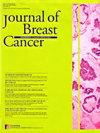新辅助化疗和新辅助化疗联合免疫疗法导致三阴性乳腺癌肿瘤缩小模式不同
IF 2.4
4区 医学
Q3 ONCOLOGY
引用次数: 0
摘要
引言 本研究旨在探讨在三阴性乳腺癌(TNBC)患者中,与单纯新辅助化疗(NAC)相比,基于磁共振成像(MRI)的新辅助化疗联合免疫疗法(NACI)是否会导致不同的肿瘤缩小模式。此外,该研究还探讨了肿瘤缩小模式与疗效之间的关系。 方法 这项回顾性研究纳入了从 2019 年 1 月到 2021 年 7 月在本中心接受 NAC 或 NACI 治疗的 TNBC 患者。每位患者均获得了治疗前和治疗后的磁共振成像结果,肿瘤缩小模式分为以下三类:1)同心缩小(CS);2)弥漫缩小;3)无变化。比较了 NAC 组和 NACI 组的肿瘤缩小模式,并评估了这些模式与疗效的相关性。 结果 99 名患者中,65 人接受了 NAC 治疗,34 人接受了 NACI 治疗。在 NAC 组和 NACI 组分别有 53% 和 20% 的患者观察到 CS 模式。在 NAC 组和 NACI 组分别有 36% 和 68% 的患者观察到弥漫性减少模式。治疗方案(NAC 和 NACI)与肿瘤缩小模式之间的关系具有统计学意义(P=0.004)。NAC组和NACI组的术后病理完全反应率(pCR)分别为45%和82%(p<0.001)。在 NACI 组中,17% 的 CS 型患者和 56% 的弥漫性缩小型患者获得了 pCR(p=0.903)。在 NACI 组中,所有肿瘤缩小模式都与较高的 pCR 率有关。 结论 我们的研究表明,与 NACI 相比,NACI 后肿瘤缩小的弥漫性减少模式更为常见。此外,我们的研究结果表明,在接受 NACI 治疗的 TNBC 患者中,所有肿瘤缩小模式都与高 pCR 率相关。本文章由计算机程序翻译,如有差异,请以英文原文为准。
Neoadjuvant Chemotherapy and Neoadjuvant Chemotherapy with Immunotherapy Result in Defferent Tumor Shrinkage Patterns in Triple-negative Breast Cancer.
INTRODUCTION This study aims to explore whether neoadjuvant chemotherapy with immunotherapy (NACI) leads to different tumor shrinkage patterns, based on magnetic resonance imaging (MRI), compared to neoadjuvant chemotherapy (NAC) alone in patients with triple-negative breast cancer (TNBC). Additionally, the study investigates the relationship between tumor shrinkage patterns and treatment efficacy was investigated. METHODS This retrospective study included patients with TNBC patients receiving NAC or NACI from January 2019 until July 2021 at our center. Pre- and post-treatment MRI results were obtained for each patient, and tumor shrinkage patterns were classified into three categories as follows: 1) concentric shrinkage (CS); 2) diffuse decrease; and 3) no change. Tumor shrinkage patterns were compared between the NAC and NACI groups, and the relevance of the patterns to treatment efficacy was assessed. RESULTS Of the 99 patients, 65 received NAC and 34 received NACI. The CS pattern was observed in 53% and 20% of patients in the NAC and NACI groups, respectively. Diffuse decrease pattern was observed in 36% and 68% of patients in the NAC and NACI groups. The association between the treatment regimens (NAC and NACI) and tumor shrinkage patterns was statistically significant (p=0.004). The postoperative pathological complete response (pCR) rate was 45% and 82% in the NAC and NACI groups (p<0.001), respectively. In the NACI group, 17% of patients with the CS pattern and 56% of those with the diffuse decrease pattern achieved pCR (p=0.903). All tumor shrinkage patterns were associated with achieved a high pCR rate in the NACI group. CONCLUSION Our study demonstrates that the diffuse decrease pattern of tumor shrinkage is more common following NACI than that following NAC. Furthermore, our findings suggest that all tumor shrinkage patterns are associated with a high pCR rate in patients with TNBC treated with NACI.
求助全文
通过发布文献求助,成功后即可免费获取论文全文。
去求助
来源期刊

Journal of Breast Cancer
医学-肿瘤学
CiteScore
3.80
自引率
4.20%
发文量
43
审稿时长
6-12 weeks
期刊介绍:
The Journal of Breast Cancer (abbreviated as ''J Breast Cancer'') is the official journal of the Korean Breast Cancer Society, which is issued quarterly in the last day of March, June, September, and December each year since 1998. All the contents of the Journal is available online at the official journal website (http://ejbc.kr) under open access policy. The journal aims to provide a forum for the academic communication between medical doctors, basic science researchers, and health care professionals to be interested in breast cancer. To get this aim, we publish original investigations, review articles, brief communications including case reports, editorial opinions on the topics of importance to breast cancer, and welcome new research findings and epidemiological studies, especially when they contain a regional data to grab the international reader''s interest. Although the journal is mainly dealing with the issues of breast cancer, rare cases among benign breast diseases or evidence-based scientifically written articles providing useful information for clinical practice can be published as well.
 求助内容:
求助内容: 应助结果提醒方式:
应助结果提醒方式:


